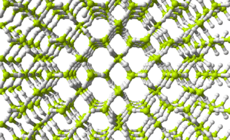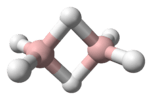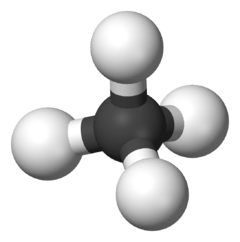Methyl radical
Methyl (also systematically named trihydridocarbon) is an organic compound with the chemical formula CH•
3 (also written as [CH
3]•). It is a metastable colourless gas, which is mainly produced in situ as a precursor to other hydrocarbons in the petroleum cracking industry. It can act as either a strong oxidant or a strong reductant, and is quite corrosive to metals.
 | |
| Names | |
|---|---|
| IUPAC name
Methyl | |
| Systematic IUPAC name
λ3-Methyl | |
| Other names
Hydrogen carbide(-III) Methyl radical | |
| Identifiers | |
3D model (JSmol) |
|
| 1696831 | |
| ChEBI | |
| ChemSpider | |
| 57 | |
| MeSH | Methyl+radical |
PubChem CID |
|
| UNII | |
CompTox Dashboard (EPA) |
|
| |
| |
| Properties | |
| CH3 | |
| Molar mass | 15.035 g·mol−1 |
Except where otherwise noted, data are given for materials in their standard state (at 25 °C [77 °F], 100 kPa). | |
| Infobox references | |
Chemical properties
Its first ionization potential (yielding the methenium ion, CH+
3) is 9.837±0.005 eV.[1]
Redox behaviour
The carbon centre in methyl can bond with electron-donating molecules by reacting:
- CH•
3 + R• → RCH
3
Because of the capture of the nucleophile (R•), methyl has oxidising character. Methyl is a strong oxidant with organic chemicals. However, it is equally a strong reductant with chemicals such as water. It does not form aqueous solutions, as it reduces water to produce methanol and elemental hydrogen:
- 2 CH•
3 + 2 H
2O → 2 CH
3OH + H
2
Structure
The molecular geometry of the methyl radical is trigonal planar (bond angles are 120°), although the energy cost of distortion to a pyramidal geometry is small. All other electron-neutral, non-conjugated alkyl radicals are pyramidalized to some extent, though with very small inversion barriers. For instance, t-butyl radical has a bond angle of 118° with a 0.7 kcal/mol barrier to pyramidal inversion. On the other hand, substitution of hydrogen atoms by more electronegative substituents leads to radicals with a strongly pyramidal geometry (112°), such as the trifluoromethyl radical, CF3, with a much more substantial inversion barrier of around 25 kcal/mol.[2]
Chemical reactions
Methyl undergoes the typical chemical reactions of a radical. Below approximately 1,100 °C (2,010 °F), it rapidly dimerises to form ethane. Upon treatment with an alcohol, it converts to methane and either an alkoxy or hydroxyalkyl. Reduction of methyl gives methane. When heated above, at most, 1,400 °C (2,550 °F), methyl decomposes to produce methylidyne and elemental hydrogen, or to produce methylene and atomic hydrogen:
- CH•
3 → CH• + H
2 - CH•
3 → CH•
2 + H•
Methyl is very corrosive to metals, forming methylated metal compounds:
- M + n CH•
3 → M(CH3)n
Production
Biosynthesis
Some radical SAM enzymes generate methyl radicals by reduction of S-adenosylmethionine.[3]
Acetone photolysis
It can be produced by the ultraviolet photodissociation of acetone vapour at 193 nm:[4]
- C
3H
6O → CO + 2 CH•
3
Halomethane photolysis
It is also produced by the ultraviolet dissociation of halomethanes:
- CH
3X → X• + CH•
3
Methane oxidation
It can also be produced by the reaction of methane with the hydroxyl radical:
- OH• + CH4 → CH•
3 + H2O
This process begins the major removal mechanism of methane from the atmosphere. The reaction occurs in the troposphere or stratosphere. In addition to being the largest known sink for atmospheric methane, this reaction is one of the most important sources of water vapor in the upper atmosphere.
This reaction in the troposphere gives a methane lifetime of 9.6 years. Two more minor sinks are soil sinks (160 year lifetime) and stratospheric loss by reaction with •OH, •Cl and •O1D in the stratosphere (120 year lifetime), giving a net lifetime of 8.4 years.[5]
Azomethane pyrolysis
Methyl radicals can also be obtained by pyrolysis of azomethane, CH3N=NCH3, in a low-pressure system.
In the interstellar medium
Methyl was discovered in interstellar medium in 2000 by a team led by Helmut Feuchtgruber who detected it using the Infrared Space Observatory. It was first detected in molecular clouds toward the centre of the Milky Way.[6]
References
- Golob, L.; Jonathan, N.; Morris, A.; Okuda, M.; Ross, K.J. (1972). "The first ionization potential of the methyl radical as determined by photoelectron spectroscopy". Journal of Electron Spectroscopy and Related Phenomena. 1 (5): 506–508. doi:10.1016/0368-2048(72)80022-7.
- Anslyn E.V. and Dougherty D.A., Modern Physical Organic Chemistry (University Science Books, 2006), p.57
- Ribbe, M. W.; Hu, Y.; Hodgson, K. O.; Hedman, B. (2014). "Biosynthesis of Nitrogenase Metalloclusters". Chemical Reviews. 114 (8): 4063–4080. doi:10.1021/cr400463x. PMC 3999185. PMID 24328215.CS1 maint: uses authors parameter (link)
- Hall, G. E.; Vanden Bout, D.; Sears, Trevor J. (1991). "Photodissociation of acetone at 193 nm: Rotational- and vibrational-state distributions of methyl fragments by diode laser absorption/gain spectroscopy". The Journal of Chemical Physics. AIP Publishing. 94 (6): 4182. Bibcode:1991JChPh..94.4182H. doi:10.1063/1.460741.
- "Trace Gases: Current Observations, Trends, and Budgets". Climate Change 2001, IPCC Third Assessment Report. IPCC/United Nations Environment Programme.
- "ISO detects a new molecule in interstellar space". Science & Technology. European Space Agency. Retrieved 17 June 2013.







